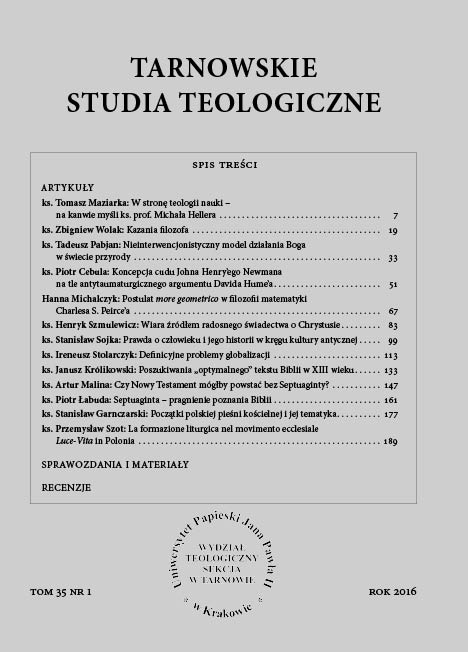Non-interventional model of the divine action in nature
DOI:
https://doi.org/10.15633/tst.1713Keywords:
non-interventional model, divine action, laws of nature, St. Thomas AquinasAbstract
This paper deals with the problem of God’s action in nature. It is argued that the divine action is always non-interventional, which means that God never violates the laws of nature. He creates the evolving universe, keeps it in existence and continously influences its history using these laws, and not breaking them. At first, the character of the laws of nature will be discussed – both in scientific and theological perspective. Later, the creative presence of God in the universe will be described. Special attention will be paid to St. Thomas Aquinas argument concerning the distinction between the first cause (which should be identified with God) and the secondary cause (which should be identified with all the physical causes explored by science). Finally, some advantages of the non-intervetnional model of the divine action in nature will be indicated.References
Clayton P., God and contemporary science, Edinburgh 1997.
Coyne G. V., Heller M., Pojmowalny wszechświat, Warszawa 2007.
Drees W. B., Czy istnieją dziury, w których działa Bóg?, [w:] Stwórca – wszechświat – człowiek, red. M. Heller, T. Sierotowicz, t. 1, Tarnów 2006, s. 216–235.
Edwards D., Jak działa Bóg?, tłum. M. Chojnacki, Kraków 2013.
Haught J. F., Odpowiedzi na 101 pytań o Boga i ewolucję, tłum. J. Kochanowicz, Kraków 2003.
Heller M., Filozofia i wszechświat, Kraków 2006.
Heller M., Ostateczne wyjaśnienia wszechświata, Kraków 2008.
Heller M., Sens życia i sens wszechświata, Tarnów 2002.
Heller M., Usprawiedliwienie wszechświata, Kraków 1995.
Peacocke A., Drogi od nauki do Boga, Poznań 2004.
Polkinghorne J., Prawa natury i prawa fizyki, [w:] Stwórca – wszechświat – człowiek, red. M. Heller, T. Sierotowicz, t. 1, Tarnów 2006, s. 200–215.
Rahner K., Christology in the setting of modern man’s understanding of himself and of his world, [w:] Theological investigations, t. 11, New York 1974, s. 215–229.
Rahner K., Pisma wybrane, tłum. G. Bubel, Kraków 2005.
Rahner K., Podstawowy wykład wiary, tłum. T. Mieszkowski, Warszawa 1987.
Rahner K., The specific character of the Christian concept of God, [w:] Theological investigations, t. 21, New York 1988, s. 185–195.
Russell R. J., Boże działanie w świecie, [w:] Stwórca – wszechświat – człowiek, red. M. Heller, T. Sierotowicz, t. 1, Tarnów 2006, s. 91–104.
Russell R. J., Cosmology: from alpha to omega, Minneapolis 2008.
Stoeger W. R., O Bożym działaniu w świecie w perspektywie naukowego poznania rzeczywistości, [w:] Stwórca – wszechświat – człowiek, red. M. Heller, T. Sierotowicz, t. 1, Tarnów 2006, s. 274–307.
Św. Tomasz, O mocy Boga. Kwestie dyskutowane, Kęty–Warszawa 2008–2009.
Św. Tomasz, Suma teologiczna, Londyn 1963–1986.
Wildman W., Ocena teleologicznych argumentów na rzecz Bożego działania w świecie, [w:] Stwórca – wszechświat – człowiek, red. M. Heller, T. Sierotowicz, t. 2, Tarnów 2006, s. 383–444.
Życiński J., Bóg i ewolucja. Podstawowe pytania ewolucjonizmu chrześcijańskiego, Lublin 2002.
Downloads
Published
Issue
Section
License
Copyright (c) 2016 Tadeusz Pabjan

This work is licensed under a Creative Commons Attribution 4.0 International License.
Authors who publish with this journal agree to the following terms:
- Authors retain the copyright and full publishing rights without restrictions, and grant the journal right of first publication with the work simultaneously licensed under a Creative Commons Attribution 4.0 International License that allows others to share the work with an acknowledgement of the work's authorship and initial publication in this journal.
- Authors are able to enter into separate, additional contractual arrangements for the non-exclusive distribution of the journal's published version of the work (e.g., post it to an institutional repository or publish it in a book), with an acknowledgement of its initial publication in this journal.
- Authors are permitted and encouraged to post their work online (e.g., in institutional repositories or on their website) prior to and during the submission process, as it can lead to productive exchanges, as well as earlier and greater citation of published work (See The Effect of Open Access).

